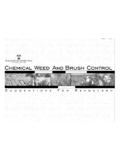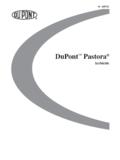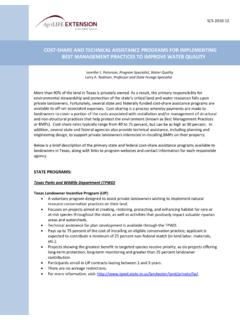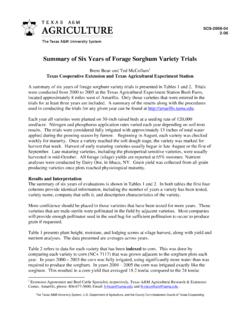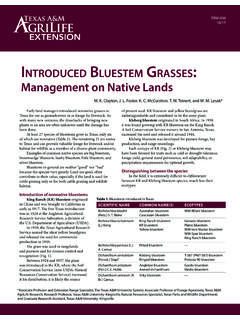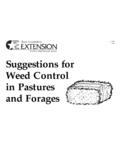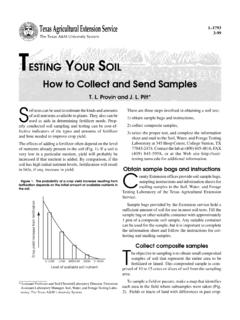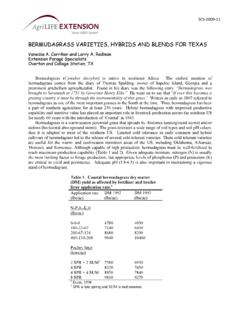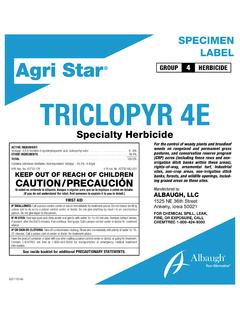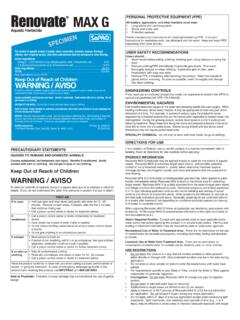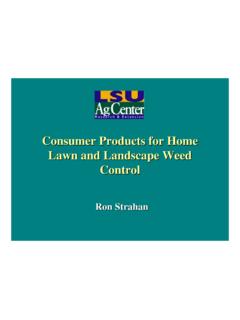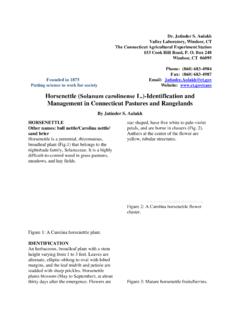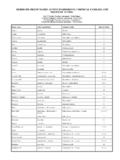Transcription of Forages
1 SCS-2001-14. Forages Herbicides Labeled for Pasture Use Larry A. Redmon and Paul A. Baumann Associate Professor & Extension forage Specialist, Overton, Texas Professor and Extension Weed Specialist, College Station, Texas Trade name Active Ingredient (form.) Controls Grazing Restrictions Ally metsulfuron (60%) broadleaf weeds, bahiagrass No grazing or hay restrictions. Amber triasulfuron (75%) broadleaf weeds No grazing restrictions. Do not cut for hay for 30 days following application. Banvel* dicamba (4 ) broadleaf weeds Remove meat animals from treated areas (dimethylamine salt) 30 days prior to slaughter. Do not harvest Clarity* dicamba (4 ) for hay before 37 days after treatment.
2 No (digyledamine salt) waiting period between treatment and grazing for non-lactating animals. Wait 7. days prior to grazing treated areas with lactating dairy animals. Cimarron metsulfuron (60%) broadleaf weeds, bahiagrass No grazing or hay restrictions. Cimarron Max* metsulfuron ( ) broadleaf weeds, bahiagrass Non-lactating animals: Remove meat dicamba + 2,4-D animals from treated areas 30 days prior to ( + ) slaughter. There is no waiting period between treatment and grazing for non-lactating animals. Lactating animals: Do not graze lactating dairy animals within 7 days of treatment. Treated grasses may be harvested for dry hay, but do not harvest within 37 days of treatment.
3 Crossbow* 2,4-D + triclopyr broadleaf weeds Grazing or harvesting green forage : ( + 1 ) 1) Lactating dairy animals: Two or less: Do not graze or harvest green forage from treated area for 14 days after treatment. Greater than two gals. up to four : Do not graze or harvest green forage until the next growing season. 2) Other livestock: Two or less: No grazing restrictions. Greater than two gals. up to four gals/ac: Do not graze or harvest green forage from treated area for Trade name Active Ingredient (form.) Controls Grazing Restrictions Crossbow* (continued) 14 days after treatment. NOTE: If Iess than 25% of a grazed area is treated, there is no grazing restriction.
4 Haying (harvesting of dried forage ): 1) Lactating dairy animals: Do not harvest hay until next growing season. 2) Other livestock: Two or less: Do not harvest hay for 7 days after treatment. Greater than two gals. up to four : Do not harvest hay for 14. days after treatment. Slaughter Animals: Withdraw livestock from grazing treated grass or consumption of treated hay at least 3 days before slaughter. Fuego* triasulfuron + broadleaf weeds Except for lactating dairy animals there are diglycolamine salt no grazing restrictions. Do not graze salt of dicamba lactating animals for 7 days after application. (75% + 4 ) Animals cannot be removed for slaughter less than 30 days after application.
5 Grazon P+D* picloram + 2,4-D broadleaf weeds Grazing: Do not allow lactating dairy ( + 2 ) animals to graze treated areas within 7 days after application. Do not harvest grass cut for hay from treated areas for 30 days after application. Meat animals must be withdrawn from treated forage at least 3 days before slaughter. No grazing restrictions for non- lactating dairy animals or other livestock. Plateau imazapic grassy weeds in Refer to label for tolerant bermudagrass (2 ) bermudagrass variety information and recommended application timing. Rave* dicamba + triasulfuron broadleaf weeds Except for lactating dairy animals, there (55% + ) are no grazing restrictions following application of Rave.
6 Treated areas should not be grazed by lactating dairy animals before 7 days after treatment. Animals cannot be removed from treated areas for slaughter less than 30 days after application. Reclaim clopyralid (3 ) woody species (mesquite) No grazing or hay restrictions. Redeem triclopyr + clopyralid woody species + Grazing or harvesting green forage : ( + broadleaf weeds 1) Lactating dairy animals ) Do not graze or harvest green forage from treated area for 14 days after treatment. 2) Other livestock including cattle, horses, sheep, goats, etc.: No grazing restrictions. Haying: 1) Lactating dairy animals: Do not harvest hay until the next growing season.
7 2) Other livestock: Do not harvest hay for 7 days after treatment. Trade name Active Ingredient (form.) Controls Grazing Restrictions Remedy triclopyr woody species Grazing or harvesting green forage : (4 ) 1) Lactating dairy animals: Two or less: Do not graze or harvest green forage from treated area for 14 days. Greater than two quarts up to six quarts/ac: Do not graze or harvest green forage until next growing season. 2) Other livestock: Two or less: None. Greater than two qts. up to six : Do not graze or harvest green forage from treated areas for 14 days. If less than 25%. of the grazed area istreated, there are no grazing restrictions. Hay harvest: 1) Lactating dairy animals: Do not harvest hay until next growing season.
8 2) Other livestock: Two or less: Do not harvest hay for 7 days after than two to four : Do not harvest hay for 14 days after treatment. Greater than four : Do not harvest hay until next growing season. Slaughter Restrictions: Withdraw grazing livestock from treated grass or consumption of treated hay at least 3 days before slaughter This restriction applies to grazing during the season following treatment or hay harvested during the season following treatment. Roundup glyphosate broadleaves, grasses, For Spot Treatment and Wiper UltraMax (5 ) and sedges Application: Apply in areas where the movement of domestic livestock can be controlled. No more than 1/10 acre should be treated at one time.
9 Remove domestic livestock before application and wait 14 days after application before grazing livestock or harvesting. Preplant, Preemergence, and Pasture Renovation: Remove domestic livestock before application and wait 8 weeks after application before grazing or harvesting. Spike 20P tebuthiuron woody species Grazing: If treated area is to be used for (20%) haying or grazing, do not apply > 20 Do not apply more than 20 in areas receiving more than 20 inches of annual precipitation,or 10 in areas receiving 20 inches or less of annual precipitation. Haying: Do not cut treated area for hay for one year. Tordon 22K* picloram woody species, When applying more than 1 , do not cut (2 ) prickly pear grass for feed within 2 weeks after treatment.
10 Meat animals grazing for up to 2 weeks after treatment should be removed from treated areas 3 days prior to slaughter. Do not graze lactating dairy animals on treated areas within 2 weeks after treatment. Do not harvest hay from treated grain fields. Trade name Active Ingredient (form.) Controls Grazing Restrictions 2,4-D amine* 2, 4-dichlorophenoxy broadleaf weeds Do not apply later than 30 days prior to acetic acid hay harvest. Do not graze meat animals (several formulations) on treated areas within 3 days of slaughter. Do not graze dairy animals within 7 days of application. 2,4-DB 200* 4-(2, 4- dichlorophenoxy) broadleaf weeds in seedling Do not graze established alfalfa or feed butyric acid and established alfalfa, straw or hay from treated alfalfa within 30.
